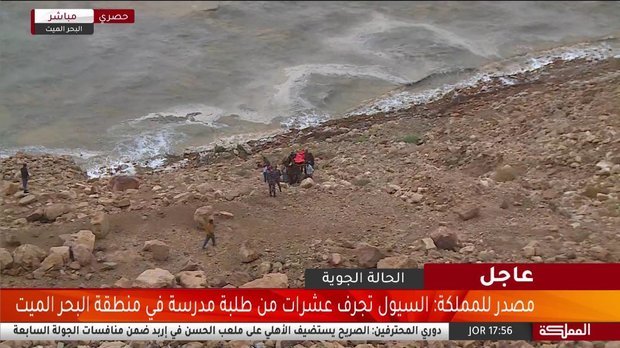Anhar Kochneva: ''Flooding and mudflows are the scourges of arid Near East''
Why did the tragedy in Jordan happen?
An awful tragedy happened in Jordan – an excursion bus was washed away by mudflow from the bridge. There are tens of victims, the bridge has been destroyed. In addition, this scourge caused some indignation among some Russians: how there can be mudflows in Near East that has plenty of deserts. In a column written for Realnoe Vremya, Near Eastern journalist and columnist of our newspaper Anhar Kochneva explains that such natural phenomena such flooding and mudflows aren't a rare thing in the region.
Half of bridge washed away with bus
Few people living in Russia can presuppose that flooding and mudflows are one the scourges of arid Near East. However, these natural phenomena aren't a wonder even for this region. I had to go through a huge puddle of rainwater on a highway with two tourists from Russia last June. The car was half submerged in water. Everything that fell like heavy rainfalls in the mountain was rushing to the sea along which our car was driving in fact. A woman died in the mudflow caused by the same flooding on the other side of the Lebanon Mountains: a flow of mud broke into her flat on the first floor. She simply suffocated…
Mudflows have become the cause of an awful tragedy in Jordan these days. A half of the bridge was washed away by a flow of water and mud on the highway connecting Aqaba (a city in the Red Sea) and the Dead Sea. It was washed away together with an excursion bus, which had a big group of schoolchildren with four children. At the moment, it's said about 20 casualties (there are missing people), a university team's coach is among them. He was on the scene of the tragedy, tried to save dying children and himself became a victim of the natural catastrophe…
The bridge that connected the Dead Sea with the Aqaba region has been destroyed. It seems that agricultural territories located in the south of the Dead Sea have been affected (thanks to specifics of the climate and the soil, delicious tomatoes are grown there). Beautiful landscapes have been destroyed. Mourning for the dead has been announced in Jordan.

It's possible to sink or freeze in the desert
I don't stay tuned for such events deliberately. However, such cases (maybe just with a smaller number of victims) in the same Jordan aren't a rare thing. A car is washed away by a sudden flow in the desert. Tourists go missing (several tourists died in the summer in similar circumstances in the mountains of neighbouring Israel). I wrote about one of such cases in my guide to Jordan 14 years ago. A mudflow that suddenly broke into the Siq ravine on 8 April 1963 took the lives of 28 people – tourists from France and their Jordan guide. The ancient Nabataean water tunnel was cleaned again afterwards (it was probably built to prevent such tragedies in the past, 2,000 years ago…).
Yes, one can sink in the desert or freeze – it sometimes snows in the mountains on the Sinai Peninsula, in Jordan, in Lebanon and even in Saudi Arabia. Considering the peculiarity of the climate where at least 5 degrees must be deducted from a thermometer reading to understand the real temperature (how it feels like). +7 at night go below zero. In brief, it's far from being summer. Though it's not Oymyakon.
#سيول_الاردن من تبوك pic.twitter.com/vj6RpsBvmu
— محمد البلوي (@wGnrAmPtq3XMcbz) 25 октября 2018 г.
Going on a trip to the Near Eastern region in autumn and winter, please, remember this. It will at least save you from a hurried purchase of winter clothes upon arrival at the holiday destination. And don't trust comments on different tourist forums like ''I've been there twice, it's always been warm and sunny there'': every year is different.
One will have to change tourist routes
In fact, nothing surprising has happened from a perspective of nature. The place, where the tragedy took place – the Arabah valley (Wādī ʻAraba in Arabic) – is a part of a huge split that begins in the north of the Lebanese Beqaa Valley and ends somewhere near Mozambique and is called Great Rift Valley. It appeared when the continents split to have the shapes we got used to seeing today. From an ordinary person's point of view, it's a huge crack in the ground where water flows, which appeared when mountains broke up, have always rushed to and have done it almost since it appeared, which is quite logical.
#وش_تفكر_فيه_الان منظر مهيب نادر ما يتكرر في #السعودية عندما يلتقي السيل مع البحر و كأنه نهر جارف pic.twitter.com/rRN53a9CQd
— الجهني (@eed0299) 26 октября 2018 г.
Another case is that many people began talking about the corruption component of this misfortune immediately after the tragedy, why the region still has bridges built during the Ottoman ruling that don't collapse, that's to say, some 100 years ago, but the bridges, which have been built recently, fall to the sea together with children. Who was responsible for the construction of this project? Who was responsible for its technical state?
The so-called high season still goes on in Jordan and in the whole Near Eastern region when it's hard to find a room in popular hotels, there aren't free tourist vehicles and guides to go on an excursion, and there are crowds of tourists. Now many travellers will have to change the routes they planned beforehand due to the destruction of the bridge. It's unclear at the moment when the normal transport communication on the road on the picturesque Dead Sea coast will be restored.